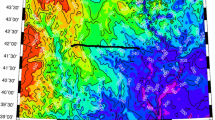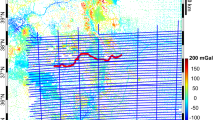Abstract
In the summer of 2017, the National Geodetic Survey (NGS) conducted its third and final Geoid Slope Validation Survey in the rugged terrain of southern Colorado, USA. As in previous surveys, the intent is to acquire the most accurate and precise field observations to determine geoid slopes. In turn, these data can be used to quantify the accuracy of various geoid models as NGS looks ahead to creating a highly accurate gravimetric geoid model for use as a national vertical datum. Long period GPS sessions, spirit leveling, absolute gravity, and deflection of the vertical (DoV) observations were acquired along a 360 km line, ranging from 1900 to 3300 m in elevation, with a station spacing of approximately 1.6 km. Our absolute gravity and DoV datasets are unique in that they were collected at 222 field stations in highly mountainous terrain at an unprecedented observational accuracy of 10 µGal and 0.04″, respectively. Further, by employing tailored refraction corrections to the spirit leveling data, we improved the agreement between heights derived from the DoV and spirit leveling from ± 1.9 to ± 1.3 cm RMS, or by more than 30%, across the line. At all length scales, from 1.6 to 360 km, the agreement is better than 2 cm. Finally, as a description of the validation process, we compare the observations with recent NGS experimental geoid models. We find that typical agreement is at about 3–5 cm, with no single model being best at all length scales. The data from this project are freely available to the community and should serve as test beds for not only geoid modeling comparisons, but also the refinement of numerous field techniques.

















Similar content being viewed by others
Data Availability
All field data that support the findings of this study (spirit leveling, GPS, gravity, and deflection of vertical)—as well as a summary table in.xls format—are publicly available on the National Geodetic Survey web page: https://www.ngs.noaa.gov/GEOID/GSVS17/DataFiles.shtml.
Notes
Bench mark 077 was ultimately omitted from the analysis because of its location on a sharp switchback in the route. There are thus 222 final bench marks in this project, designated 001 through 223.
For logistical reasons, the A10 was not able to occupy the indoor site near bench mark 223.
References
Ahlgren K, Wang YM, Li X, Youngman M (2018) Towards a more consistent geoid model for North America. In: FIG congress 2018 proceedings, Istanbul, Turkey
Angus-Leppan PV (1984) Refraction in geodetic levelling. In: Brunner FK (ed) Geodetic refraction. Springer, Berlin. https://doi.org/10.1007/978-3-642-45583-4_8
Armstrong M, Schenewerk M, Mader G, Martin D, Stone B, Foote R (2015) OPUS projects user instructions and technical guide. https://www.ngs.noaa.gov/corbin/class_description/OPUS-Projects_UI_TG_v2.5_Approved_8-05-15.pdf. Accessed 1 June 2020
Balazs EI, Young GM (1982) Corrections applied by the National Geodetic Survey to precise leveling observations. NOAA Technical Memorandum NOS NGS 34, p 12
Fancher K (2019) NGS antenna calibration procedures. http://ngs.noaa.gov/ANTCAL/docs/NGSantcalprocedures.pdf. Accessed 14 Aug 2020
Federal Geodetic Control Committee (FGCC) (1984) Bossler JD (chairman), Standards and specifications for geodetic control networks. National Oceanic and Atmospheric Administration, Rockville, Maryland
GRAV-D Team (2017) GRAV-D general airborne gravity data user manual. Theresa Damiani, Monica Youngman, and Jeffery Johnson ed. Version 2.1. http://www.ngs.noaa.gov/GRAV-D/data_MS05.shtml. Accessed 5 Oct 2019
Guillaume S (2015) Determination of a precise gravity field for the CLIC feasibility studies, Ph.D. dissertation ETH No 22590. https://doi.org/10.3929/ethz-a-010549038
Heiskanen WA, Moritz H (1967) Physical geodesy. W.H. reeman, San Francisco
Hirt C, Flury J (2008) Astronomical-topographic levelling using high-precision astrogeodetic vertical deflections and digital terrain model data. J Geod 82(4–5):231–248. https://doi.org/10.1007/s00190-007-0173-x
Hirt C, Claessens S, Fecher T, Kuhn M, Pail R, Rexer M (2013) New ultra-high resolution picture of Earth’s gravity field. Geophys Res Lett 40(16):4279–4283. https://doi.org/10.1002/grl.50838
Hirt C, Yang M, Kuhn M, Bucha B, Kurzmann A, Pail R (2019) SRTM2gravity: an ultrahigh resolution global model of gravimetric terrain corrections. Geophys Res Lett 46(9):4618–4627. https://doi.org/10.1029/2019gl082521
Holdahl SR (1981) A model of temperature stratification for correction of leveling refraction. NOAA Technical Memorandum NOS NGS 31. Rockville, MD
Krieger G et al (2007) TanDEM-X: a satellite formation for high-resolution SAR interferometry. IEEE Trans Geosci Remote Sens 45(11):3317–3341. https://doi.org/10.1109/TGRS.2007.900693
Kukkamäki TJ (1938) Über die nivellitische Refraktion, Suom. Geod. Lait. Julk., 25, p 48
Li X, Ahlgren K, Hardy R, Krcmaric J, Wang YM (2019) The development and evaluation of the experimental gravimetric geoid model 2019. https://beta.ngs.noaa.gov/GEOID/xGEOID19/xGeoid19_tech_details.v10.pdf. Accessed 1 Feb 2020
Mader G, Schenewerk M, Weston N, Evjen J, Tadepalli K, Neti J (2012) Interactive web-based GPS network processing and adjustment using NGS’ OPUS-projects. In: Proceedings of the FIG working week 2012, Rome, Italy
Mäkinen J, Ihde J (2009) The permanent tide in height systems. In: Sideris MG (eds) Observing our changing earth. International Association of Geodesy Symposia, vol 133. Springer, Berlin. https://doi.org/10.1007/978-3-540-85426-5_10
Mayer-Gürr T, Pail R, Gruber T, Fecher T, Rexer M, Schuh WD, Kusche J, Brockmann JM, Rieser D, Zehentner N, Kvas A, Klinger B, Baur O, Höck E, Krauss S, Jäggi, A (2015) The combined satellite gravity field model GOCO05s. EGU 2015 Presentation. Vienna, Austria
Micro-g LaCoste Inc. (2008) A10 portable gravimeter user’s manual. http://microglacoste.com/pdf/A-10Manual.pdf. July 2008
National Geodetic Survey (1999) PAGES: program for the adjustment of GPS ephemerides. https://www.ngs.noaa.gov/GRD/GPS/DOC/pages/pages.html. Accessed 21 Aug 2020
National Geodetic Survey (2019) Blueprint for 2022, Part 3: working in the modernized NSRS. NOAA Technical Report NOS NGS 67. https://www.ngs.noaa.gov/PUBS_LIB/NOAA_TR_NOS_NGS_0067.pdf. Accessed 21 Aug 2020
National Geodetic Survey (2020) NAVD 88 gravity computations. https://geodesy.noaa.gov/TOOLS/Navdgrav/navdgrav.shtml. Accessed 21 Aug 2020
Niebauer T, Billson R, Schiel A, van Westrum D, Klopping F (2012) The self-attraction correction for the FG5X absolute gravity meter. Metrologia 50:1. https://doi.org/10.1088/0026-1394/50/1/1
Pavlis NK, Holmes SA, Kenyon S, Factor JK (2012) The development and evaluation of the Earth Gravitational Model 2008 (EGM2008). J Geophys Res Solid Earth 117(B4):B04406
Rebischung P, Griffiths J, Ray J, Schmid R, Collilieux X, Garayt B (2012) IGS08: the IGS realization of ITRF2008. GPS Solut 16:483–494. https://doi.org/10.1007/s10291-011-0248-2
Remmer O (1980) Refraction in levelling, Medd. 54, Geod. Instit., Copenhagen, Denmark
Sánchez L, Ågren J, Huang J, Wang YM, Mäkinen J, Pail R, Barzaghi R, Vergos G, Ahlgren K, Liu Q (2020, under review, this issue) Strategy for the realisation of the International Height Reference System (IHRS). J Geod. Special Issue on Reference Systems in Physical Geodesy
Schack P, Hirt C, Hauk M, Featherstone W, Lyon T, Guillaume S (2018) A high-precision digital astrogeodetic traverse in an area of steep geoid gradients close to the coast of Perth, Western Australia. J Geod 92(10):1143–1153. https://doi.org/10.1007/s00190-017-1107-x
Scintrex Ltd (2016) Scintrex CG 6 Autograv. https://scintrexltd.com/product/cg-6-autograv-gravity-meter/. Accessed 1 Feb 2020
Smith DA, Holmes SA, Li X, Guillaume S, Wang YM, Bürki B, Roman DR, Damiani TM (2013) Confirming regional 1 cm differential geoid accuracy from airborne gravimetry: the Geoid Slope Validation Survey of 2011. J Geod 87:885–907. https://doi.org/10.1007/s00190-013-0653-0
Stein RS, Whalen CT, Holdahl SR, Strange WE, Thatcher W (1986) Saugus-Palmdale, California, field test for refraction error in historical leveling surveys. J Geophys Res Solid Earth 91(B9):9031–9044
Strange WE (1981) The impact of refraction correction on leveling interpretations in southern California. J Geophys Res 86:2809–2824
van Westrum D (2019) Apogee relative gravity processing software (BETA). https://beta.ngs.noaa.gov/PC_PROD/APOGEE/index.shtml
Voigt C, Denker H (2011) Validation of GOCE gravity field models by Astrogeodetic Vertical Deflections in Germany, International Association of Geodesy Symposia 139. https://doi.org/10.1007/978-3-642-37222-3_38
Wang YM, Saleh J, Li X, Roman DR (2012) The US Gravimetric Geoid of 2009 (USGG2009): model development and evaluation. J Geod 86(3):165–180
Wang YM, Becker C, Mader G, Martin D, Li X, Jiang T, Breidenbach S, Geoghegan C, Winester D, Guillaume S, Bürki B (2017) The Geoid Slope Validation Survey 2014 and GRAV-D airborne gravity enhanced geoid comparison results in Iowa. J Geod 91(10):1261–1276. https://doi.org/10.1007/s00190-017-1022-1
Wang YM, Sánchez L, Ågren J, Huang J, Forsberg R, Abd-Elmotaal HA, Barzaghi R, Bašić T, Carrion D, Claessens S, Erol B, Erol S, Filmer M, Grigoriadis VN, Isik MS, Jiang T, Koç Ö, Li X, Ahlgren K, Krcmaric J, Liu Q, Matsuo K, Natsiopoulos DA, Novák P, Pail R, Pitoňák M, Schmidt M, Varga M, Vergos GS, Véronneau M, Willberg M, Zingerle P (2020, under review, this issue) Colorado geoid computation experiment—overview and summary. J Geod. Special Issue on Reference Systems in Physical Geodesy
Whalen CT (1981) Results of leveling refraction tests by the National Geodetic Survey. NOAA Technical Report NOS 92 NGS 22. Rockville, MD
Wilkins T, Kanney J (2020, under review) Left hand canyon gravity calibration baseline. NOAA Technical Memorandum NOS NGS TBD. National Geodetic Survey, Silver Spring, MD
Zilkoski DB, Richards JH, Young GM (1992) Results of the general adjustment of the North American Vertical Datum of 1988. Surv Land Inf Syst 52(3):133–149
Acknowledgements
This work would not have been possible without the dedicated efforts of both the field crews and analysis teams of the National Geodetic Survey. The authors wish to express their sincere thanks for their efforts in often challenging environments and situations. We would also like to express our extreme gratitude to the Technical Universities of both Zurich and Munich for their generous assistance with Deflection of the Vertical instrumentation and personnel. Next, we cannot stress enough how helpful the Colorado Department of Transportation was in not only coordinating crew safety during the survey, but also with the huge task of initially installing the survey bench marks. Finally, our appreciation goes out to the numerous communities along US Highway 160 who welcomed and accommodated our survey crews and expressed interest in our project.
Author information
Authors and Affiliations
Contributions
All authors listed below contributed substantially to this work and reviewed its findings. All authors discussed the results and contributed to writing the manuscript. Specifically: Derek van Westrum: Responsible for management of field data acquisition and analysis, and coordination of data reduction and model comparisons. Kevin Ahlgren: Responsible for geoid model description and comparison analysis. Also responsible for leveling analysis and comparisons. Christian Hirt: Responsible for deflection of vertical field data quality control, as well as the description of the calculation of geoid undulations from the DoV data. Sebastien Guillaume: Responsible for the deflection of vertical hardware installation calibration, as well as the analysis of the DoV field data.
Corresponding author
Rights and permissions
About this article
Cite this article
van Westrum, D., Ahlgren, K., Hirt, C. et al. A Geoid Slope Validation Survey (2017) in the rugged terrain of Colorado, USA. J Geod 95, 9 (2021). https://doi.org/10.1007/s00190-020-01463-8
Received:
Accepted:
Published:
DOI: https://doi.org/10.1007/s00190-020-01463-8




